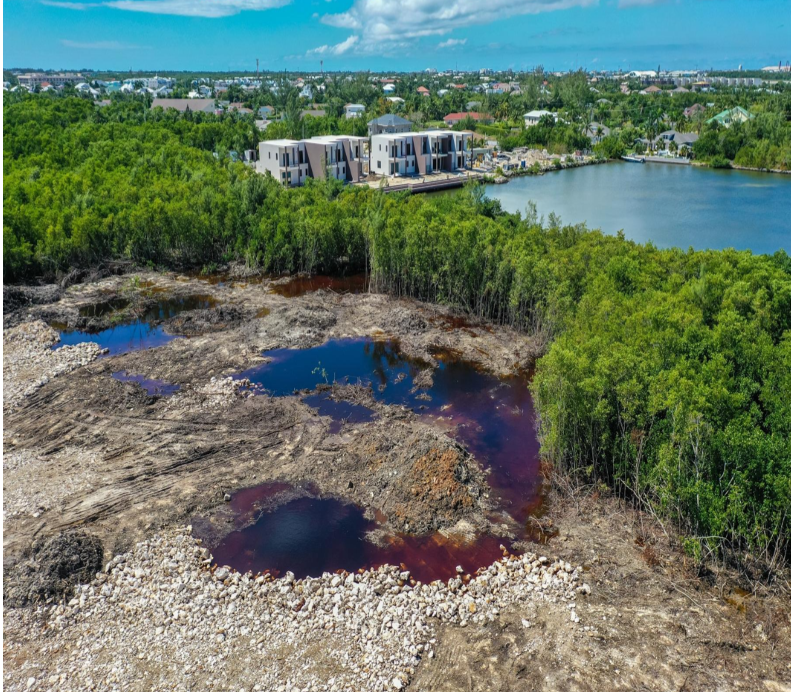Unchecked mangrove destruction poses threat to Cayman


Despite laws protecting Cayman’s mangrove habitat and the proven utility of wetlands in mitigating climate change impacts, mangrove destruction continues at a dangerous pace.
The Cayman Islands Mangrove Rangers are alarmed by the ongoing practice of speculative and premature land clearing, rubber stamped by the Central Planning Authority (CPA), which has left lots of formerly healthy mangrove barren across Grand Cayman. Examples of ill-advised mangrove clearing can be found in every district, but the rangers have flagged two cases in particular representing around 75 acres of wetland habitat.

Mangrove die-off around landfill
North of the unlined George Town landfill more than 20 acres of mangrove between the landfill and Camana Bay have fallen victim to die-off. The avoidable ecological destruction here has been exacerbated by construction of the airport connector road and the lack of culverts to manage run-off. Despite the visibility of this lifeless forest from the roadway it has not been made clear to the public how toxic run-off will be prevented under current landfill mitigation efforts. Culverts between the dykes and the mangroves are one measure that would have helped maintain the hydrology necessary for the mangroves to survive.
Unfortunately, it has become commonplace in Cayman to sacrifice natural areas to poor land management and later reward such practices by greenlighting further construction on the now barren parcels.
As the proposed extension of the East-West Connector nears this case should be taken as a learning opportunity to prevent needless destruction and prove that the Cayman Islands Government takes its stated environmental values seriously. The existing stretch between Red Bay and Savannah is singularly devoid of any culverts. The hydrological flow here must be maintained in order for the habitat to survive.
If the practice of piecemeal sub-division and lack of flood planning continues, Cayman risks destruction of its Central Mangrove Wetlands, the largest contiguous mangrove wetlands in the Caribbean. Best practices in construction and road projects must be implemented with urgency. Otherwise, Grand Cayman’s eastern reaches risk the fate of West Bay’s wetlands, now less than a quarter of their historic acreage.


Clearing of Red Bay’s largest-remaining wetland
In the Prospect/Red Bay community the clearing of the area’s largest remaining mangrove habitat comprising 53 acres near Selkirk Road, is in full swing. The approval of this subdivision application which calls for five apartment lots and 74 residential lots has moved ahead without clear plans for construction.
Despite objectors who raised concerns about the proposal’s mangrove impact the CPA has insisted that the issue of preserving natural habitat be reserved for a later date.
“The authority noted that the protection of mangroves comes at the stage of reviewing building applications,” the CPA wrote.
Extensive land clearing has already begun, however, and once the application process reaches the building proposal stage it will be too late to discuss protection of mangrove habitat. Mangrove restoration is an incredibly difficult process with low success rates. The best way to conserve mangrove is to prevent their destruction in the first place.
This clearing, approved by the CPA without building plans, illustrates the willingness of government planning authorities to permit the large-scale destruction of Grand Cayman’s greatest natural asset against flooding and hurricanes. Government planners are well aware of the threats that climate change poses to our low-lying islands. Continued disregard for environmental advice willfully puts our community in danger’s way.
We urge the project developers, Ergun Berksoy alongside Whittaker and Watler, to follow National Conservation Council and Department of Environment advice to hold off on further land clearing until development is imminent. The fresh water pond identified on the western boundary of the property must also be preserved as a matter of priority, to conserve habitat for native invertebrates and birds, including West Indian whistling ducks and heron.
Wetland conservation is not only essential to preserving Cayman’s natural beauty, it provides immense benefit to the community through storm and flood protection. These natural spaces also provide important benefits to mental health and can be sources of education and recreation, if properly marketed and preserved.
The cumulative impact of this development – including compounded drainage/flooding problems, sewage disposal concerns, release of greenhouse gasses and wildlife elimination – has not been adequately addressed. The CPA has noted that many objectors who claim they were not informed of the development during the notification period, did not have their concerns recognized by the authority.
We encourage the CPA to review its notification process, still dependent on postal mail service, to ensure that neighbours are properly informed of proposals and may practice their legal right to object.
As the Cayman Islands Government strives to lower greenhouse gas emissions, we also remind them that mangroves are incredibly efficient at storing carbon. When mangroves are destroyed, that carbon is then released back into the atmosphere, compromising our islands’ climate change objectives.


Mangrov die-off story
Aerial photography by Jonathan Schutte.




